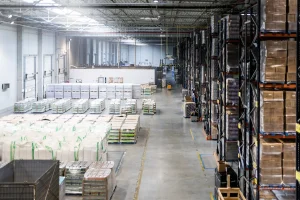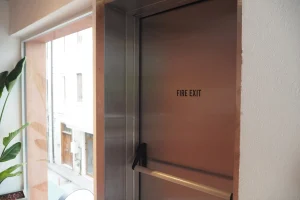If you manage a warehouse or industrial facility in the Philippines, understanding fire door requirements is a must. Fire doors, or fire exit doors, aren’t just building features; they play a major role in protecting people and property during a fire.
Knowing the fire door requirement helps you stay compliant with local building and safety laws while keeping your staff and assets safe. This article explains the key fire door requirements in the Philippines, covering the Fire Code of the Philippines, NFPA 80 standards, and standard fire exit door sizes.
What are the Requirements for a Fire Door?
A fire door is built to prevent the spread of fire and smoke between sections of a building. It must have a fire-resistance rating that matches its surrounding wall or partition. This rating, usually measured in minutes or hours, ensures the door can withstand fire long enough to allow safe evacuation.
According to the Fire Code of the Philippines (RA 9514), fire-rated doors must close automatically, latch securely, and remain unmodified from their certified condition. Even a small alteration can void the fire rating. Routine inspections help keep them in good working condition and compliant with safety standards.
What Makes a Fire-Rated Door Compliant
A compliant fire-rated door has a certified fire-resistance label that indicates how long it can withstand fire; commonly 60 or 90 minutes. It must include hardware such as hinges, locks, and closers that are also approved for fire-rated use.
Under NFPA 80, fire-rated doors must:
- Be self-closing and positively latched
- Have minimal gaps between the door and frame
- Remain free from unapproved modifications
- Be inspected regularly to stay in working condition
While NFPA 80 is a U.S. standard, it is widely referenced in the Philippines because it complements local fire safety laws.
Who Inspects Industrial Fire Doors in the Philippines
Fire door inspection and approval are handled by the Bureau of Fire Protection (BFP), the main government agency responsible for enforcing RA 9514. Before a business can legally operate, the BFP must conduct a Fire Safety Inspection to verify that all fire safety systems, including doors, exits, alarms, and extinguishers, meet the required standards.
During inspections, the BFP checks:
- Whether fire-rated doors are installed in all designated fire barriers and exit routes
- If the fire exit door standard size meets local regulations
- Whether the door assembly has a valid label or certification
- The door’s self-closing and latching functions
- Accessibility and ease of egress during emergencies
Once a facility passes inspection, it receives a Fire Safety Inspection Certificate (FSIC), which is required for business permit applications and renewals. Inspections are typically done annually or whenever major changes are made to the building layout or safety systems.
For warehouses and industrial sites, maintaining compliance also involves periodic self-checks. Owners can request guidance from the BFP or hire certified fire door inspectors to perform pre-assessment inspections to identify possible violations before an official visit.
Why Regular Fire Door Maintenance Matters
Even if a fire door is properly installed, poor maintenance can cause compliance issues. A malfunctioning closer, missing label, or damaged frame can lead to failed inspections and increased fire risk. Regular upkeep not only helps meet NFPA 80 fire door requirements but also ensures safety systems perform as expected during emergencies.
Here are some quick maintenance practices:
- Clean and lubricate hinges and closers regularly
- Replace worn or damaged seals and hardware
- Keep fire exit signage visible and illuminated
- Avoid repainting over certification labels
- Test self-closing devices and latches at least once a month
By keeping these doors in good working condition, you maintain both legal compliance and occupant safety.
Fire Door Standards for Warehouses and Industrial Buildings
Warehouses and industrial sites face higher fire risks due to machinery, storage materials, and fuel sources. Fire doors in these spaces serve as barriers that divide work areas, storage zones, and exits.
To stay compliant:
- Use fire-rated doors in areas where fire may start or spread easily.
- Keep exit routes clear and make sure doors open toward the direction of travel.
- Avoid wedging fire doors open, as this can prevent them from closing automatically during a fire.
- Have all doors inspected regularly for proper operation and visible labeling.
Practical Steps for Compliance
Understanding fire door requirements is one thing, but actually following them in day-to-day operations is another. Warehouses and industrial facilities must balance productivity with safety, and compliance can sometimes feel complex. These steps will help you stay aligned with the Fire Code of the Philippines, NFPA 80 fire door requirements, and local building standards without overcomplicating the process.
1. Confirm Fire Door Ratings
Verify that every fire door in your building carries a valid fire-resistance label. The rating must match the wall or partition’s fire-resistance level, especially in areas with flammable materials. Unlabeled doors are often flagged during BFP inspections.
2. Verify Installation
Even the best fire door won’t function correctly if it’s installed improperly. Make sure each door swings toward the direction of escape and closes automatically without obstruction. All hinges, closers, and latches must be intact and in good condition. Avoid installing additional locks, glass panels, or other modifications not approved by the manufacturer, as these can void the door’s certification.
For new constructions or major renovations, it’s best to coordinate with a DOLE-accredited safety practitioner or fire safety engineer who can confirm that installations meet both RA 9514 and NFPA 80 standards.
3. Maintain Proper Door Sizes and Clear Paths
Follow the standard fire exit door size in the Philippines; at least 90 cm wide and 2 m high. Larger buildings may require additional exits to meet travel distance requirements. Keep all exits free from obstructions like pallets or machinery.
4. Schedule Regular Inspections
Compliance doesn’t end after installation. Fire doors must be inspected at least once a year; or more often in facilities with heavy foot traffic or exposure to heat and chemicals. During inspections, check for issues like:
- Damaged or missing door seals
- Rusted or worn hinges and latches
- Gaps larger than 3 mm between the door and frame
- Missing or unreadable certification labels
- Improperly functioning closers or locks
It’s best to document all maintenance activities. Having a fire door inspection log helps demonstrate compliance during BFP audits and business permit renewals.
5. Coordinate with the Bureau of Fire Protection (BFP)
The BFP is responsible for enforcing fire safety laws and issuing certifications. Contact your local BFP office to schedule inspections, review fire exit layouts, and verify that your door installations meet RA 9514 standards. Consistent communication helps prevent delays and penalties.
6. Train Staff and Keep Records
Employees should know how to use fire exits correctly and understand why fire doors must remain closed. Keep all inspection reports, maintenance logs, and BFP documents organized and accessible for audits.
Ensure Safety with a Trusted Fire Exit Doors Supplier
Meeting the fire door requirement in the Philippines is more than just compliance; it’s about protecting lives, equipment, and investments. Warehouses and industrial buildings face higher fire risks, so having certified fire exit doors and regular inspections is essential.
If your facility needs fire-rated or fire-exit doors that meet the Fire Code of the Philippines and NFPA 80 standards, work with a reliable local supplier. Janus Steel offers high-quality fire doors designed for performance, safety, and compliance. Contact us today to learn more about our range of products and start securing your building with trusted, regulation-ready fire doors.





